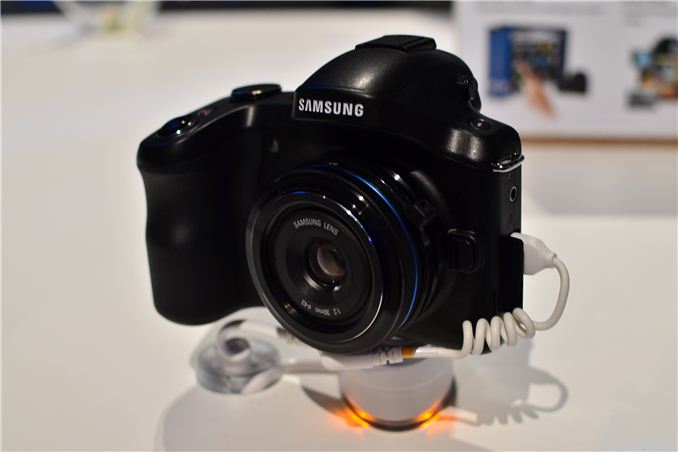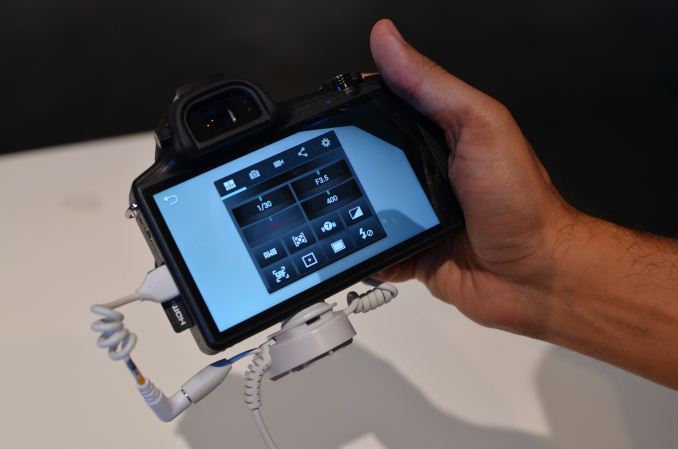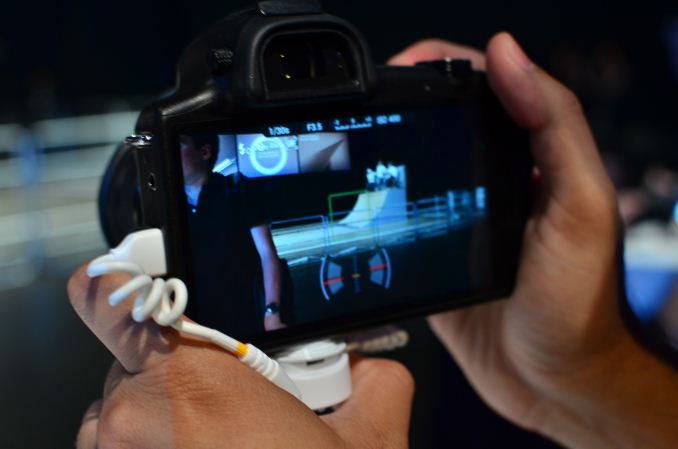Samsung Galaxy NX Camera: Hands On
by Anand Lal Shimpi on June 20, 2013 7:06 PM EST- Posted in
- Smartphones
- Samsung
- camera
- Mobile

When Samsung launched the Galaxy Camera, I remember Brian telling me that it might not be the best point and shoot, but it's absolutely the directions cameras need to go in. After playing with the Galaxy Camera, I couldn't agree more. Cameras need to be connected, as sharing is such an important part of the whole point of taking photos. At tonight's Premiere 2013 event in London, Samsung unveiled its next flagship connected camera: the Galaxy NX Camera.
The Galaxy NX Camera is the first Android camera to support interchangeable lenses. As its name implies, the Galaxy NX Camera is fully compatible with all currently available Samsung NX lenses. The Galaxy NX Camera features a 20.3MP APS-C sensor (Update: Brian tracked down the exact sensor).
Internally there's a 1.6GHz quad-core SoC with a dedicated ISP. The platform runs Android 4.2.2 and supports LTE as well.
The big thing for me? We finally have an Android device that exposes full manual controls. Shutter speed, aperture and ISO are all adjustable just like on a traditional camera. While the layout took some getting used to, the frustrating lack of control from most camera experiences on Android just wasn't there. The combination of software flexibility and the ability to use good lenses will make this yet another step in the right direction.
Taking photos was just as natural as on any other mirrorless camera. The 4.8" display looks good and there's even a live level indicator to help make sure your shots come out straight. Start-up/shutdown time are impacted by the simple fact that the whole thing runs Android. I can't wait to get one of these in Brian's hands to see what he thinks once review samples are available. Modern smartphones have done a tremendous job of pulling focus away from traditional PCs for mobile computing, it's very clear that the traditional camera market is set to be disrupted by these portable powerhouses even more going forward.
| Camera Emphasized Smartphone Comparison | ||||||||
| Samsung Galaxy Camera (EK-GC100) | Nikon Coolpix S800c | Nokia PureView 808 | Samsung Galaxy S4 Zoom | Samsung Galaxy NX Camera | ||||
| CMOS Resolution | 16.3 MP | 16.0 MP | 41 MP | 16.3 MP | 20.3 MP | |||
| CMOS Format | 1/2.3", 1.34µm pixels | 1/2.3", 1.34µm pixels | 1/1.2", 1.4µm pixels | 1/2.3", 1.34µm pixels | APS-C, 4.25µm pixels | |||
| CMOS Size | 6.17mm x 4.55mm | 6.17mm x 4.55mm | 10.67mm x 8.00mm | 6.17mm x 4.55mm | 23.5mm x 15.7mm | |||
| Lens Details |
4.1 - 86mm (22 - 447 35mm equiv) F/2.8-5.9 OIS |
4.5 - 45.0mm (25-250 35mm equiv) F/3.2-5.8 |
8.02mm (28mm 35mm equiv) F/2.4 |
4.3 - 43mm (24-240 mm 35mm equiv) F/3.1-F/6.3 OIS |
NX Mount ILC, shown with 18-55mm F/3.5-5.6 | |||
| Display | 1280 x 720 (4.8" diagonal) | 854 x 480 (3.5" diagonal) | 640 x 360 (4.0" diagonal) | 960 x 540 (4.3-inch) | 1280 x 720 (4.8-inch) LCD | |||
| SoC | Exynos 4412 (Cortex-A9MP4 at 1.4 GHz with Mali-400 MP4) | ARM Cortex A5(?) | 1.3 GHz ARM11 | 1.5 GHz Exynos 4212 | 1.6 GHz Quad Core (Exynos 4412?) | |||
| Storage | 8 GB + microSDXC | 1.7 GB + microSDHC | 16 GB + microSDHC | 8 GB + microSDHC | 16 GB + microSDXC | |||
| Video Recording | 1080p30, 480p120 | 1080p30 | 1080p30 | 1080p30 | 1080p25 | |||
| OS | Android 4.1 | Android 2.3.6 | Symbian Belle | Android 4.2 | Android 4.2.2 | |||
| Connectivity |
Quad band WCDMA 21.1, 4G, 802.11a/b/g/n with 40 MHz channels, BT 4.0, GNSS |
No cellular, WiFi 802.11b/g/n(?), GPS | Pentaband WCDMA 14.4, 802.11b/g/n, BT 3.0, GPS | Quad band WCDMA 21.1, 4G LTE SKUs, 802.11a/b/g/n with 40 MHz channels, BT 4.0, GNSS |
Quad band WCDMA 42 4G LTE SKUs, 802.11a/b/g/n, BT 4.0, GNSS |
|||


















30 Comments
View All Comments
haplo602 - Friday, June 21, 2013 - link
This is a typical solution waiting for a problem that will never exist. I fail to see any positives of this camera:1. It is not a good camera since it lacks manual photographic controls (you know, buttons and dials)
2. It needs a data plan but cannot do much with it. How many do you already have ? Phone ? Tablet ? Now this camera ?
3. It is SLOW because of Android.
Basicaly what Samsung needs to do is incorporate proper BT/WIFI connectivity into a camera, not just the bullshit android/ios apps. Proper WIFI tethering. We usualy already have a smartphone that can do the comms part, connecting the camera to it and creating a proper workflow is the part that's missing. Hell there are apps for smartphones for flickr, facebook, google+ and the lot. All that's missing is proper integration.
One last comment: Why the EVF if the camera is fully touch controlled ? If you need to change ANYTHING, you have to look at the bloody screen and tap it. EVF is just another expense that won't be used much if at all.
The only positive thing is the app market. But if Andoid cannot fully control the camera inside and serves just for after shot workflow, then that's a negative again.
hughlle - Friday, June 21, 2013 - link
Lets just hope that the wireless connectivity is better than what they currently offer. I bought one of their current wifi cameras, used the wi-fi once, and didn't bother using it again. Why would i spend the money on a camera that takes great pictures, for the camera to destroy the image quality so as to send it as a smaller file. I just emailed myself a photo i took earlier in the week, the original file is 4.38mb, the emailed copy comes out at 473kb and looks horrendous.jimmyzaas - Friday, June 21, 2013 - link
I don't understand all the hate. When I change settings using the dials and buttons, I'm still looking at my screen. Maybe all you guys are so pro, you don't even need to confirm the correct settings. Perhaps your dials and buttons have braille on them, and you know exactly which one is for aperture and which one is for shutter, etc. Out of most of the regular people I know, we all look at the screen while we are using the dial and buttons anyway. So why wouldn't this work? Wouldn't this be even easier to navigate than to go through dials and buttons? I don't think this device was ever intended for hardcore DSLR users anyway. I mean they made it like a phone so most people can just pick it up and go.My only concern is battery life and start up time. These are the two things that irritate me from android devices. With a quadcore 1.6 SoC, you really have to wonder. Will I only have enough juice for 2 hours of photography? Maybe 30 minutes only with flash.
Anyway I think this is a really awesome idea. It reminds me of when apple released the iPhone while we were all using those regular flip phones. It forces the other big guys to wake up if they want to stay alive in the camera business.
evonitzer - Sunday, June 23, 2013 - link
I agree. Absurd hate from people with no imagination (and presumably no DSLR's or they would have realized the limitations that crop up from time to time). But in regards to battery life, hopefully they will cram a huge battery into this thing. Space isn't as much of a constraint as in a phone, so the battery should be enormous. Not sure if it is swappable like most cameras, but changing batteries isn't a big deal if so. As long as boot up time is less than 30 seconds.secretmanofagent - Sunday, June 23, 2013 - link
Well, I can think of a couple issues. When I'm changing settings, I'm still looking through the viewfinder because it's showing me what I'm changing. There's more limited information if it's an SLR as opposed to an electronic viewfinder, but I'm still able to do what I need to through the viewfinder (with the exception of reviewing the shot, which the electronic viewfinder already does). An electronic viewfinder model that I have I essentially never look at the display, as all the information it could is already shown in the viewfinder. I change mode, adjust settings, without ever looking at the main display. Why is that an issue? It helps me take pictures without having to recompose the shot because I already have it framed the way I want it.The bigger problem with an electronic viewfinder (assuming it is) is that it will automatically preview the settings. In low-light conditions, this can be a major hindrance, as I've had to try to take pictures without knowing exactly where the camera was pointed (longer exposure).
The leveling isn't unique to the Samsung (Sony A77 and Nikon D7000 have it as well, for example), but it's interesting for them to include it. As much as I dislike Samsung as a company, it's an interesting model and the battery life would be interesting to determine. They're trying to play in the bigger leagues, so it'll be interesting how the lens quality, ISO, and other aspects of what people expect from a camera play out.
Impulses - Thursday, June 27, 2013 - link
That was one of the few truly informed comments here... Frankly I think it's a miss for several reasons beyond the lack of manual controls (though that's certainly a big factor), but the concept has promise. I just don't think it'll be truly realized for another few years.First of all, there's already plenty of super connected mirrorless cameras and DSLRs and compacts are getting there as well. With a current gen Panasonic Lumix G-series you even get NFC to make the initial connection as painless as possible (no need to type passwords, scan codes, etc) and once paired you can view and initiate image transfers from a phone/tablet as well as take full control of thecamera. Sony's NEX cameras have a similarly rich implementation (minus NFC) and they even let you install apps and additional features...
So what does having an Android powered ILC camera really add to that experience beyond unnecessary complexity and potential battery/performance downsides? Not much at the moment IMO, in the future it could lead to more open and customizable camera firmware which could really blow up the market but that will only happen if the concept even catches on and Samsung (or whomever) then commits to an API or some other avenue for customization.
Beyond that, this particular model is larger than lost other mirrorless models... Which isn't a bad thing in and of itself, mirrorless doesn't have to mean small and there's many advantages to a mirrorless camera with a good OLED EVF vs a DSLR... But this particular model doesn't do anything that smaller and possibly cheaper mirrorless models do (yet), while sacrificing size which is one of the two or three major advantages over a DSLR.
Sony's NEX system and Olympus/Panasonic's micro four thirds have a far larger share of the mirrorless ILC market, and more developed lens systems, without them jumping on board I don't see Android on cameras catching on in the short term unless Samsung pulls some impressive surprises on the software side (as far as letting developers truly run with it etc, some of Samsung's cameras have terrible interfaces to begin with).
Impulses - Thursday, June 27, 2013 - link
I'm a big supporter of Android and I dig the concept in theory btw, I just don't think this particular model is anything special and I'm not too confident Samsung by themselves will really get it right even with a second or third gen product... I'm glad they're putting it out there tho.Gmarley - Thursday, June 27, 2013 - link
Most SLR's even one level above the intro models have several ergonomically placed dedicated physical controls. My index finger controls shutter speed, my thumb controls aperture, and the rest of the parameters are accessible without going into a menu or taking my eye from the viewfinder. You use one for 10 or 20 hours and it becomes second nature, and impossible to go back to anything else.shorty lickens - Saturday, June 22, 2013 - link
If they had a standby mode they could reduce startup times. My D40 might be lacking in many ways but at least it can start shooting in about a second.529th - Saturday, June 22, 2013 - link
I'm sure your photos won't be private even before YOU decide to share them.